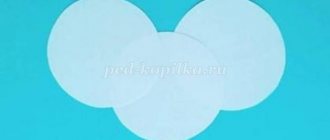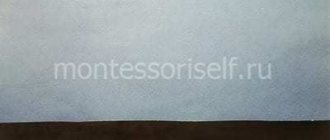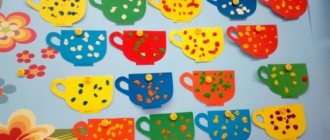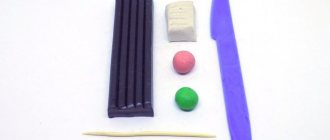Pea jesters made of different materials
A simple template for making a product from geometric shapes. Transfer them to cardboard and help your child cut them out. Stick on any background. This way you can repeat the learned names of the figures with preschoolers.
To create, you will need paper tubes. Prepare different colors. Cut into small rectangles and roll them into tubes. Stick them in place of the hair. The bow should be made of tubes. And draw a face.
Just make a composition out of buttons. Select brightly colored objects and stick them together. For better fixation, use superglue and thick cardboard.
Pasta compositions are made in a similar way. Only after gluing the pasta are painted with gouache.
The technique of torn appliqué is also relevant. Often the pieces are cut into arbitrary rectangles, squares or torn by hand.
Children especially like to create with plasticine. Combine business with pleasure and create a funny jester. This is done using plasticine balls (like a mosaic) or two-dimensionally rolling out the plasticine into the desired shapes.
Freeze this product a little and store away from the sun and high temperatures.
Create an interesting creation from mini-modules. Take small squares of double-sided colored paper. Fold them into simple modules.
Fold one corner first.
Then the opposite one from above.
Prepare the stencil. And stick the blanks on it in any order. Even preschoolers can complete such modules.
It is also made using mixed technique. Use natural herbarium and ordinary A4 sheets.
Clown made of paper palms. Offer the children colored A4 and cardboard. Help glue the elements together, and the craft is ready.
For your next masterpiece, prepare colorful fabric, balloons and glue. Roll the strips into tight spirals. Stick them on the desired parts of the picture. The collar may consist of rubber balls.
The eyelashes are made from cotton swabs, and the mouth is made from floss threads.
We will need scraps of old colorful clothes. Prepare 4 different cuts and other necessary things.
Cut out the stencils and transfer the outlines onto the canvas. Choose one that will not come apart during use. If it's satin, burn the edges.
Glue the parts onto cardboard. If the fabric is thick, use superglue. Help identify the front and back of the product. Close the joints with buttons. Lay the collar with an “accordion” made of loose fabric or a candy wrapper.
Fabric applique "Clown"
In this type of needlework there are many different techniques for performing crafts. In this MK we will consider the technology of making a clown applique from pieces of fabric. It will also not be difficult for children if adults help them understand the step-by-step description of the work. So, in the preparatory group, children were asked to work with an appliqué made of fabric, pieces of which will be glued to a sheet of cardboard. In addition, children's crafts will look bright and funny if the clown himself is painted. Interesting additions will be applique elements made of fabric, threads or other decorative elements. Another option for clown applique is to apply the contours of the design to a fabric base and secure the details using satin stitches. In this master class we offer several interesting ideas. Pictures can be printed on a printer and then cut out as a stencil.
- To complete the appliqué in these two ways, the preschooler first needs to copy the drawing onto a sheet of paper. Then all parts need to be numbered, starting from the bottom and in turn from bottom to top.
- Cut the pattern into its component parts and cut them out from the prepared piece of fabric.
- Determine the location of the drawing by laying out the blanks in front of you.
- Now glue the individual parts of the clown applique to a cardboard sheet or sew to fabric using a sewing machine. This will be the final stage of the craft.
Preliminary work. Preparing the basis for a collective composition (a large sheet of paper: at the bottom there is a magician’s hat, cut out of paper and glued semi-volumely, tricks “fly out” from the hat - 2-3 ribbon applications (for example, doves, flowers, stars, candies, gloves, socks). See picture.
Materials, tools, equipment. Strips and rectangles of colored paper, scissors, glue, glue brushes, napkins, simple pencils for drawing an element, colored pencils and felt-tip pens for adding graphic elements to the application. Unfinished composition “Magician’s Hat” with two or three tricks (ribbon appliqués).
Recommended aids, clarity.
Posters “Circus”, “Zoo”, “Multiple”, “Composition of the number 5”, “Composition of the number 10”.
A set of technological maps for sculpting “Circus”.
Unfinished composition “Magician’s Hat” (applique).
Contents of the lesson.
A teacher in a magician's cloak and top hat performs a trick (takes out a New Year's garland from his hat). Then he shows the children the unfinished composition “Magician’s Hat”, prepared in advance in independent artistic activity, and invites the children to come up with and make their own tricks that will “fly out” of the hat. Then the teacher introduces the children to a new way of cutting out paper folded like an accordion or in half twice or four times (depending on the softness of the paper).
Look at this trick (at this time the teacher unfolds one of the ribbon cutouts, for example, doves, flowers, stars, apples or candies). You see, all the doves (or flowers, apples, candies - elements of the ribbon applique) are connected to each other in the form of a chain or New Year's garland. And you can do it like this. I take a strip of paper, fold it in half, in half again, draw a picture, for example, a Christmas tree, so that the lower branches fall on the fold. I cut, trying to leave the lower branches at the bends uncut. These branches will hold on to each other, and you will get a round dance like this. And if you accidentally cut the design on the folds of the paper, the Christmas trees will separate and the “round dance” will not work.
Children come up with their own tricks, fold strips of paper like an accordion or in half twice, draw one element with a simple pencil (for example, candy, a ball, a bird, an umbrella...), bringing out some elements of the drawing on the folds, and show it to the teacher. The teacher checks that the parts on the folds are fixed and reminds them that they cannot cut at this point. Children cut out along a self-drawn outline, unfold their “tricks” and, if desired, complement them with drawings or appliqué. For those children who have recently come to kindergarten or who are not very skilled with scissors, the teacher suggests making a focus garland from individual elements -
circles, triangles, stars, leaves, beetles, etc. All children transfer their “tricks” (ribbon appliques) to the general composition “Magician’s Hat”, place them beautifully and freely, and carefully glue them.
At the end of the lesson, the teacher asks the children if they can find new unusual tricks on their tables or in paper scrap boxes. Children discover the remains of those strips of paper from which the silhouette “tricks” were cut out. The teacher advises attaching these strips with a through-cut pattern to colored paper and, if desired, sticking them on. (This work can be continued after the lesson in independent artistic activity or in an art studio class.)
After class. In their free time, children, at their own discretion, complement the composition “Magician’s Hat” and, with the participation of the teacher, turn it into a circus poster.
The teacher reads to the children a short fairy tale by V. Krotov “A trick with a magician”:
A magician came to one city on tour. He performed all the tricks himself, but for one he needed an assistant. He called young Kyu from the hall and asked in a whisper: when he disappears, count to three and hit the chair with his wand. But Kyu forgot what to hit. She started knocking here and there, at random. So many things appeared: a goose, a cactus, a bicycle, a bucket of water, but there was no magician. Finally she touched the leg of the chair, and a magician appeared under the chair. But he was not offended and even gave young Kyu a cactus.
Color applique of a clown made from candy wrappers
Circus is joy, kindness, a lot of positive emotions and good mood. Who is the most fun and funny in the arena? You guessed it - a clown. Children fell in love with this character, and therefore not only in kindergarten you can get into a world where there are jokes and laughter; make a funny clown at home yourself.
Step-by-step photo instructions for the “Clown” applique
The MK presented below is done by children in the senior group of kindergarten as it is a little more complicated than the previous one.
- Prepare background material.
- Cut out a pair of boots using the template.
- Cut the corners and cut out the pants and sleeves.
- Make a face and attach a bow.
- Cut out the eyes. You can line the eyes with whole candies, the main thing is the round shape.
- Next, make a cap for the head according to the diagram.
- Glue the prepared figures onto colored background paper, draw eyelashes, smiling lips, and hair.
Our funny clown is ready.
Video: Candy Clown
In this lesson we will look at how to make a clown from scrap materials - from candy wrappers. To do this, you need to collect a lot of bright candy wrappers in advance, you will also need free time and desire.
Make a candy clown with care and please your loved ones with a new application, give moments of good mood to everyone who looks at it. So, let's start watching the video.
Working with plasticine
An equally original clown is made from plasticine, and even the smallest craftsmen can work with this material under the guidance or together with their parents.
We start work by designing the head.
We will make the body from two oblong elements of different colors, and immediately decorate it with buttons and an openwork collar. We insert a wooden stick into the upper part and place the head on it.
We fashion wide sleeves, attach them to the body, and complement them with yellow “fists”. All that remains is to make boots with plasticine pom-poms.






